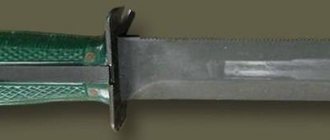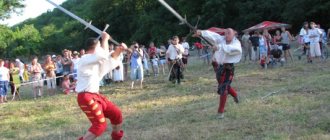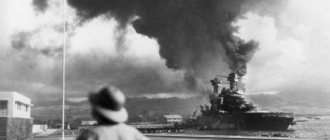Serbosek
(Croatian Srbosjek, literally -
Serborez
) - a blade on a rough leather glove. Used by the Croatian Ustasha[1][2][3]. It had a handle that fit on the hand. “Serborez” did not have a set shape; it could vary from a converted scythe to high-quality factory blades longer than 30 cm.
The sheaf knife (German: Garbenmesser), used as a serbosec and which became the prototype for specialized handicraft and factory analogues, has been produced since 1926 by the German [ source not specified 282 days
], had a peaceful agricultural purpose and a blade length of 5-7 cm [4].
A new version of the “serbosek” was developed after the Croatian government of Ante Pavelic held a special competition on the question: what kind of knife should be made so that executioners could kill people as quickly as possible and with as little fatigue as possible[2].
A batch of “serborez” was manufactured during the Second World War by a factory in the German city of Solingen on a special order from the government of the Independent State of Croatia. Knives from this batch were used for the massacre of Serbs in the Jasenovac concentration camp and other places[1][2][3]. Such a knife had the inscription “Gräwiso” on the leather part of the knife [ source not specified 282 days
], and is therefore sometimes called a "graviso knife".
Nikola Nikolic describes the Serbosek, which fell into the hands of the Yugoslav partisans, as having a 12-centimeter blade and a blade on the outside [5].
In the Jasenovac concentration camp, competitions took place regarding the speed of killing with the “Serbosek”. According to American researcher Howard Bloom, the winner of one of the competitions, Petar Brzica, killed 1,300 Serbs [6] in one night (according to other sources - 1,360 [7]).
Notes[ | ]
- ↑ 12
Jasenovacki logor smrti, Dr. Nikola Nikolic, 1948. - ↑ 1 2 3 Dr.
Mladen Colic. Takozvana NDH. Belgrade: Deltapres, 1973. - ↑ 1 2 Dedijer V.
Vatikan i Jasenovac, Dokumenti. - Beograd: Rad, 1987. - DHM Objektdatenbank (undefined). Retrieved October 19, 2017.
- Eberhard Rondholz.
Zweierlei Erinnerung.
Jasenovac – Das kroatische Auschwitz (undefined)
.
DEUTSCHLANDFUNK
20. DEUTSCHLANDFUNK (28.08.2009). — “Unseren Partisanen fiel einmal ein Schlachtmesser in die Hände. Es handelte sich dabei um ein 12 cm langes, gekrümmtes Messer, dessen Schneide sich am äußersten gekrümmten Rand befand. Die Klinge war an einer gewölbten, ovalen Kupferplatte und diese wiederum an einem dicken Lederarmband befestigt. Das Lederarmband, das ein Loch zum Durchstecken des Daumens aufwies, trug man um das Handgelenk. Die restlichen Finger blieben frei. An der unteren Kante zog man das Armband mit Lederriemen fest.” - Bloom H.
Wanted! : The Search for Nazis in America. — Quadrangle / New York Times Book Co., 1977. - Ristevski D.
Psihološka rehabilitacija Srbije. — Narodna knj. Alfa, 1997. - P. 148.
LiveInternetLiveInternet
"Ustasha"
- an ultranationalist wing of the Croatian opposition against the centralized social structure of the Kingdom of Yugoslavia, in other words, a fascist organization against the unity of Yugoslavia, its forerunner was
the Croatian Party of Law
, which takes radical anti-Yugoslav positions. Ante Pavelić was in its ranks as secretary.
But the dominant political force in Croatia at that time was the Croatian Peasant Party
under the leadership of Stepan Radic. Then he was killed right in the parliament building by Serbian nationalists. King Alexander I dissolved parliament on January 6, 1929, declared the 1921 constitution invalid and proclaimed a royal dictatorship under which all nationalist movements were banned.
A day later, Ante Pavelić strengthened the Ustasha movement and emigrated to Italy, from which he conducted his subversive activities against the Yugoslav state, pursuing the only goal - to determine the geographical and administrative scope of the powers of local authorities.
The Ustasha saw themselves as fighters for independence from Serbian hegemony within Yugoslavia, setting as their goal the creation of an ethnically pure, independent Croatia. From the very beginning, the Ustasha movement was created to pursue a policy of genocide. Later, they increasingly took on fascist features, focusing on the examples of Hitler and Mussolini.
Under the pseudonym Hadjia, Ante Pavelić was the commandant of the Ustasha camp in Boveno (near Brescia), where he trained terrorists to carry out political assassinations. And in 1934, they, together with the Bulgarian nationalists VMORO, killed that same King of Yugoslavia, Alexander I, in Marseille.
The main area of activity of the Ustaše was the creation of support groups among Croatian emigrants, awaiting the possibility of seizing power in Croatia with German or Italian help.
After the occupation of Yugoslavia by German troops on April 10, 1941, the creation of the Independent State of Croatia (Nezavisna Država Hrvatska; NGH) was proclaimed.
Ante Pavelić took over as Governor of Croatia from 1941 to 1945.
with the support of the Nazis and Italian fascists.
The Germans occupied the most industrialized and densely populated areas and began to use their resources for their military needs. On June 6, 1941, the Germans also determined the final borders of the NDH: during Pavelic’s meeting with Hitler, the latter agreed to include Bosnia, Herzegovina and Sandzak in the NDH. The Ustasha declared Bosnia and Herzegovina “the original Croatian land.”
With the rank of governor, Pavelić concentrated all power in his hands and contributed to the creation of a cult of personality around himself. The Ustasha movement grew into the only party in the country. In parallel to the conscription-based army, following the example of the German SS, special military units of the Ustaše (Croatian: Ustaška vojnica) were created. The most famous fighting unit was the Black Legion (Croatian: Crna Legija) led by Major Jure Francetić.
On April 30, 1941, laws were passed according to which all non-Aryan citizens (Croats were also classified as Aryans) were outlawed, only an Aryan could become a citizen of the NGH, the rest were considered “belonging to the state.”
On the same day, the Laws on Race and the Protection of Aryan Blood and the Honor of the Croatian People were adopted, prohibiting interethnic marriages. At the same time, on August 12, 1922, Ante Pavelić married Maria Lovrenchevic, whose family included Jews.
Ethnic cleansing was widely used in the NDH, accompanied by the mass extermination of Serbs. And this was the most terrible manifestation of Nazism, Slavic brothers killed Slavic brothers, firmly believing that they were Aryans and the Serbs were not.
After the Ustasha came to power, policies were pursued aimed at deepening linguistic differences between Serbia and Croatia. The Croatian language was declared a separate language, never having anything in common with Serbian. Numerous neologisms were artificially invented (munjovoz - tram, slikopis - cinema, krilnik - general, etc.), which disappeared from use after the war.
Serbs, Jews, Gypsies and Croatian anti-fascists were imprisoned in concentration and extermination camps. The largest of the camps was the Jasenovac complex
, in which prisoners were killed with particular cruelty. Jasenovac was a conveyor belt of death. The greatest number of victims were among the Serbs. In Jasenovac they burned people alive en masse or cut up living people with special knives.
After the Croatian government of Ante Pavelic held a special competition on the question: “What kind of knife should be made so that executioners could kill people as quickly as possible and with as little fatigue as possible,”
For these tasks, a special knife was made - “Serbosek”, by a factory in the German city of Solingen on a special order.
Serbosek had a handle that fit on the hand, with the inscription "Gräwiso" on the leather part of the knife.
There were even competitions on the speed of killing with a “serbosek”.
The Bosnian Muslims, on the contrary, were classified by the Ustasha as Croats of the Muslim faith and were officially given equal rights to Catholics!!!
“In a desperate struggle for its existence, Croatia shows at every step that it is ready to remain faithful to Catholic traditions and is ready to create a purer and better prospect for the Catholic Church in this part of the world...”
In relation to the Orthodox population, the Ustasha pursued a policy of extreme oppression, due to the situation where certain ethnic circles historically held political and religious views that were undesirable to the Ustasha.
A policy of forced conversion to Catholicism was practiced. Although membership in the Ustasha was prohibited to clerics, some former priests themselves took part in crimes.
Former Franciscan monk Miroslav Filipović from the Petricevac monastery participated in the extermination of 2,730 Serbs, including 500 children from neighboring villages. Subsequently, he became the main guard of the Jasenovac concentration camp and received the nickname “Brother Satan.”
One of the members of the Catholic official organization "Krizari" - Petar Brzica, working in the Jasenovac concentration camp, became famous as the "King of Serbicide". Using a silver cutter, he cut the throats of 1,360 prisoners in one day. For this, from the hands of the camp chaplain he received a gold watch, from the camp administration a silver service, and from the Ustasha who served with him in the camp, a baked pig and wine.
Franciscan Srečko Peric addressed the Croats with a speech:
“Croat brothers, go and slaughter all the Serbs, and first kill my sister, who married a Serb, and then all the Serbs in order. When you are done with this, come to my church, I will confess you and all your sins will be forgiven”!!!!!!!!!!!!!!!!!
Throughout the war, the Vatican maintained full diplomatic relations with the Ustasha state and had a papal nuncio in Zagreb.
(No, I don’t understand, it’s just how could one forgive the Vatican, first for so many centuries of witch hunts, then this?! They still walk in gold and no one has a conscience for this monstrous past of the Catholic Church... )
A year after the mass extermination of the Orthodox Serbian population, Archbishop Aloysius Stepenac presented the events of the genocide of Orthodox Christians in Croatia in his report to Pope Pius XII, blaming the Serbs, Chetniks and Communists: “No one will be allowed to attack the Independent State of Croatia and present the Croats in a bad light.”
The scale of the genocide in Croatia forced even Mussolini to provide refuge in Italy for Serbs and Jews fleeing the Ustasha regime. The Nazis also criticized the Ustasha for the Serbian genocide (since they supported the “friendly” puppet government of Milan Nedic in Serbia), but did not take practical action to stop the terror.
Until 1945, the Ustasha regime was a loyal ally of the Third Reich and sent its own divisions in support of the German attack on the Soviet Union. The main field of his military activity, however, was the fight against Tito's People's Liberation Army of Yugoslavia and the Serbian national-monarchist Chetniks.
The results of studies by Bogoljub Kočović and Vladimir Žerjavić on the number of victims in World War II in Yugoslavia indicate that
the Ustasha killed about 290 thousand of the 1.9 million Serbs living in the country, almost all 40 thousand Jews and 30 thousand Roma.
According to other sources, more than 400 thousand Serbs were killed.
The Croats killed by the Ustasha are a group of political and religious opponents of the regime, both Catholics and Muslims. It is believed that between 5,000 and 12,000 Croats died in Jasenovac alone.
After the victory of the Anti-Fascist Coalition in World War II in May 1945, many members of the Ustasha regime fled abroad. The remnants of the Ustasha, parts of the army (Domobrani) and Serbian and Slovenian nationalist detachments hostile to Tito surrendered to the British in today's Austria, but were handed over back to the Yugoslav communists, who shot most of them. The mass execution of the Ustasha in the Austrian city of Bleiburg received in history the name Bleiburg Massacre.
The organizer of the murder of hundreds of thousands of Yugoslav residents, Ante Pavelić fled Yugoslavia in 1945 (sentenced to death in absentia by the Yugoslav People's Court) with the help of Catholic priests. Pavelić arrived in Argentina in 1947 and lived until the late 1950s in Buenos Aires, where he served as security adviser to Argentine dictator Juan Perón. There he founded the so-called Croatian “government in exile”, not recognized by any state. Died December 28, 1959 in Madrid.
From the circles of Ustasha emigrants, terrorist underground groups were formed in Germany, the USA, Canada, Australia and Argentina and declared themselves the “Croatian liberation movement”. It planned and carried out assassinations on Yugoslav politicians, officials and ordinary people, as well as on its former members who left the movement.
Since Croatia's independence (in the early 1990s), some nationalist political groups have attempted to continue the Ustasha traditions. In 1991-1995, some Croatian formations fighting against Serbs and Bosnian Muslims proclaimed the Ustasha as their models.
With the connivance of the Croatian authorities of that time, the unofficial rehabilitation of the Ustashes began, many streets and objects were renamed in their honor, and the activities of the Ustashes were repeatedly portrayed in a positive tone in the press and on television.
Objects renamed in honor of figures of the Ustasha regime were returned to their previous names only in 2003 with the coming to power of Ivo Sanader, who belonged to the Croatian Democratic Community (HDZ), the largest Croatian party, which again advocated national independence
…
The initiator and active promoter of the policy of genocide was also the famous Croatian writer, minister of education and deputy dictator Pavelic, Mile Budak, who was executed by the partisans after the war. But in our again troubled times of either ignorance of history or revaluation of values, attempts are being made in Croatia to rehabilitate him, his nationalist anti-Serbian books are published in large editions.
Monument to the victims of Jasenovac:
The history of the kitchen knife
Knives were one of the first tools that humanity learned to use. The oldest specimens found were stone ones from the Paleolithic era, more than 12 thousand years old.
- In ancient times, they did not compete with other types of primitive weapons. Their light weight and convenient dimensions have become decisive for finishing and cutting game and subsequent processing of skins. They were made of stone, wood, bone.
- Just 5 thousand years ago, man learned to mine metal and process it. From that time on, the history of the metal knife began as one of the main human tools.
- The first metal blades were made of copper, bronze, silver, and gold. The latter were used mainly for ritual purposes, as they were too rare and very expensive metals. Iron came to replace them a little later, practically displacing these metals from the production of knives.
- A thousand years ago there was no such thing as a “special kitchen knife”. There were “combat” ones, used respectively in battles, hunting and “domestic” ones. As professions evolve, the knife evolves, acquiring various qualities depending on the type of application. The cook had a thinner blade, a sharper sharpening, because his task was to carefully cut food, and not rough chopping or chopping.
In a modern kitchen, in addition to convenient and practical knives, special scissors are also used in the cooking process. You can see a huge variety of all kinds of shapes and types of kitchen tools in the catalog section https://mygipfel.ru/nozhi-i-nozhnitsy/.
Let's take a closer look at the structure of a kitchen knife.
- The main part is the blade itself. It can be considered high quality if it is made by turning from a forged blank. Such blades are durable, reliable, and do not require additional sharpening for a long time.
- The shape of the tip determines the functionality.
- The top edge, or butt, is often straight, sometimes downward in models with a centered tip.
- The sharpened part of the blade comes in two types: cutting and sawing for crumbly or juicy products.
- The thickening between the blade and the handle is called a bolster. It helps close the seam and improves balance.
- The safety guard protects the hand from slipping while cutting.
- Handles are made from various materials. Their main feature is the ergonomic shape; the surface of a high-quality handle should not be slippery.
All kinds of knives are in the sets section on the page https://mygipfel.ru/nozhi-i-nozhnitsy/nabory-nozhej/. The thickness, curve of the blade, and shape are ideal for certain types of culinary work. You can choose any possible combination for yourself, find kitchen tools in a wide variety of designs. From sets in the style of hi-tech, minimalism to multi-colored models, which will be a pleasure for you to cook and for your children to learn cooking.
"Source: mygipfel.ru"











